How Can We Help?
Zinc finger CCCH-type antiviral protein 1 is a protein that in humans is encoded by the ZC3HAV1 gene.[5][6][7]
This gene encodes a CCCH-type zinc finger protein that is thought to prevent infection by retroviruses. Studies of the rat homolog indicate that the protein may primarily function to inhibit viral gene expression and induce an innate immunity to viral infection. Alternative splicing occurs at this locus and at least four isoform variants have been described.[8][7]

References
- ^ a b c GRCh38: Ensembl release 89: ENSG00000105939 – Ensembl, May 2017
- ^ a b c GRCm38: Ensembl release 89: ENSMUSG00000029826 – Ensembl, May 2017
- ^ "Human PubMed Reference:". National Center for Biotechnology Information, U.S. National Library of Medicine.
- ^ "Mouse PubMed Reference:". National Center for Biotechnology Information, U.S. National Library of Medicine.
- ^ Gao G, Guo X, Goff SP (Sep 2002). "Inhibition of retroviral RNA production by ZAP, a CCCH-type zinc finger protein". Science. 297 (5587): 1703–6. doi:10.1126/science.1074276. PMID 12215647. S2CID 42188205.
- ^ Katoh M, Katoh M (Jul 2003). "Identification and characterization of human TIPARP gene within the CCNL amplicon at human chromosome 3q25.31". Int J Oncol. 23 (2): 541–7. doi:10.3892/ijo.23.2.541. PMID 12851707.
- ^ a b "Entrez Gene: ZC3HAV1 zinc finger CCCH-type, antiviral 1".
- ^ Ficarelli, Mattia; Neil, Stuart J.D.; Swanson, Chad M. (29 September 2021). "Targeted Restriction of Viral Gene Expression and Replication by the ZAP Antiviral System". Annual Review of Virology. 8 (1): 265–283. doi:10.1146/annurev-virology-091919-104213. ISSN 2327-056X. PMID 34129371.
Further reading
- Yu Y, Zhang C, Zhou G, et al. (2001). "Gene expression profiling in human fetal liver and identification of tissue- and developmental-stage-specific genes through compiled expression profiles and efficient cloning of full-length cDNAs". Genome Res. 11 (8): 1392–403. doi:10.1101/gr.175501. PMC 311073. PMID 11483580.
- Strausberg RL, Feingold EA, Grouse LH, et al. (2003). "Generation and initial analysis of more than 15,000 full-length human and mouse cDNA sequences". Proc. Natl. Acad. Sci. U.S.A. 99 (26): 16899–903. Bibcode:2002PNAS...9916899M. doi:10.1073/pnas.242603899. PMC 139241. PMID 12477932.
- Scherer SW, Cheung J, MacDonald JR, et al. (2003). "Human chromosome 7: DNA sequence and biology". Science. 300 (5620): 767–72. Bibcode:2003Sci...300..767S. doi:10.1126/science.1083423. PMC 2882961. PMID 12690205.
- Bick MJ, Carroll JW, Gao G, et al. (2003). "Expression of the zinc-finger antiviral protein inhibits alphavirus replication". J. Virol. 77 (21): 11555–62. doi:10.1128/JVI.77.21.11555-11562.2003. PMC 229374. PMID 14557641.
- Ota T, Suzuki Y, Nishikawa T, et al. (2004). "Complete sequencing and characterization of 21,243 full-length human cDNAs". Nat. Genet. 36 (1): 40–5. doi:10.1038/ng1285. PMID 14702039.
- Beausoleil SA, Jedrychowski M, Schwartz D, et al. (2004). "Large-scale characterization of HeLa cell nuclear phosphoproteins". Proc. Natl. Acad. Sci. U.S.A. 101 (33): 12130–5. Bibcode:2004PNAS..10112130B. doi:10.1073/pnas.0404720101. PMC 514446. PMID 15302935.
- Gerhard DS, Wagner L, Feingold EA, et al. (2004). "The status, quality, and expansion of the NIH full-length cDNA project: the Mammalian Gene Collection (MGC)". Genome Res. 14 (10B): 2121–7. doi:10.1101/gr.2596504. PMC 528928. PMID 15489334.
- Beausoleil SA, Villén J, Gerber SA, et al. (2006). "A probability-based approach for high-throughput protein phosphorylation analysis and site localization". Nat. Biotechnol. 24 (10): 1285–92. doi:10.1038/nbt1240. PMID 16964243. S2CID 14294292.
- Olsen JV, Blagoev B, Gnad F, et al. (2006). "Global, in vivo, and site-specific phosphorylation dynamics in signaling networks". Cell. 127 (3): 635–48. doi:10.1016/j.cell.2006.09.026. PMID 17081983. S2CID 7827573.
- MacDonald MR, Machlin ES, Albin OR, Levy DE (2007). "The zinc finger antiviral protein acts synergistically with an interferon-induced factor for maximal activity against alphaviruses". J. Virol. 81 (24): 13509–18. doi:10.1128/JVI.00402-07. PMC 2168828. PMID 17928353.


Recent Comments